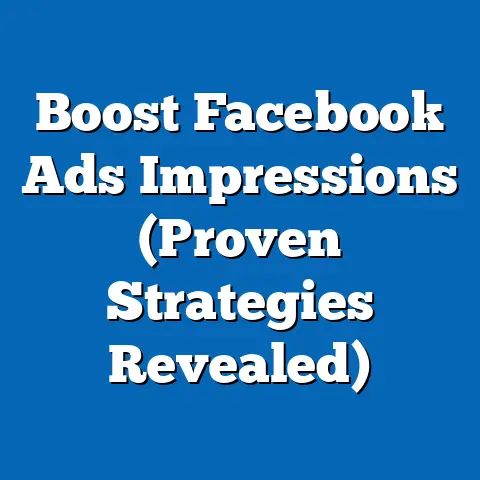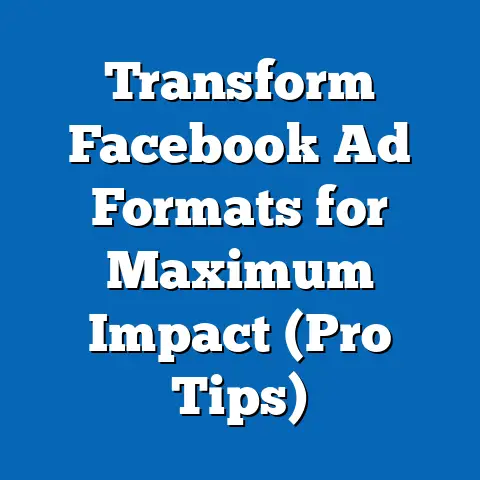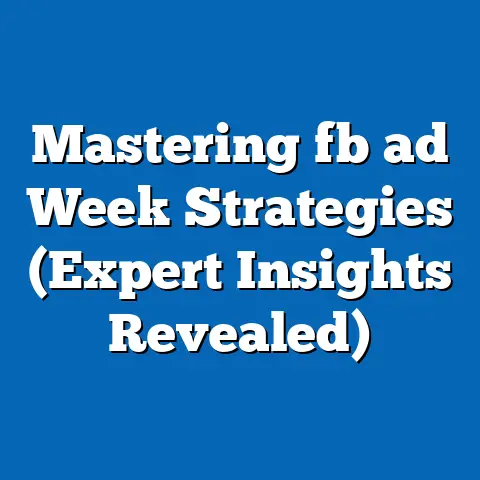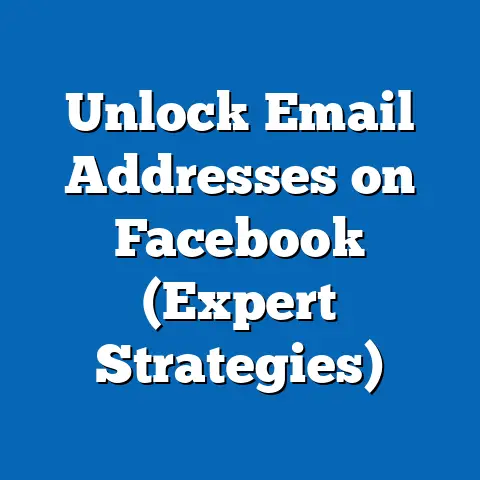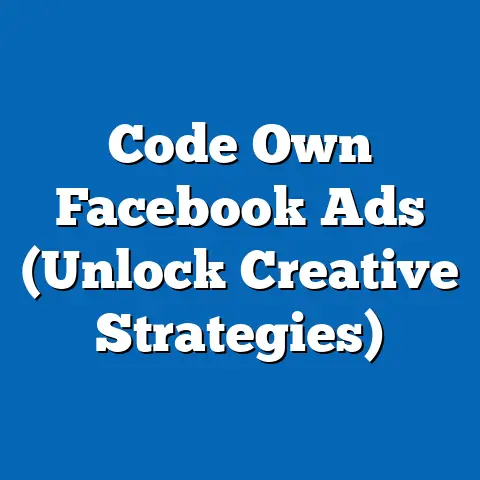Run Facebook Ads as an Admin? (Expert Insights Revealed)
Facebook advertising. It’s a term that’s probably crossed your desk (or phone screen) more times than you can count. But are you truly leveraging its power? As someone who’s spent years navigating the ever-evolving world of Facebook Ads, I can tell you it’s more than just boosting a post. It’s about strategically connecting with your audience, driving conversions, and ultimately, growing your business.
And that’s where the role of the Facebook Ads admin comes in. You might be thinking, “Is it really that different running ads as an admin?” The answer is a resounding YES. Being an admin isn’t just about having access; it’s about understanding the platform’s intricacies, wielding its tools effectively, and making data-driven decisions that impact your bottom line.
Now, I want to talk about Facebook Ads in North America. This is a unique market, brimming with opportunities but also fiercely competitive. The sheer volume of users, combined with diverse demographics and a high level of digital literacy, means your ad campaigns need to be laser-focused and incredibly creative to stand out.
What You’ll Learn:
- Understanding Facebook Ads: We’ll define Facebook Ads, explore the different types available, and navigate the Ads Manager interface.
- Setting Up Your Account: You’ll learn how to set up your Facebook Ads account correctly, manage admin roles, and understand regional compliance.
- Crafting Effective Campaigns: We’ll cover objective selection, ad content creation, A/B testing, and regional campaign examples.
- Budgeting and Bidding: You’ll understand how to set a budget, choose the right bidding strategy, and consider regional spending trends.
- Analyzing Performance: I’ll guide you on tracking key metrics, leveraging Facebook Analytics, and making data-driven decisions.
- Advanced Strategies: We’ll explore retargeting, lookalike audiences, the Facebook Pixel, and staying updated with trends.
Section 1: Understanding Facebook Ads
What are Facebook Ads?
Facebook Ads are paid messages that businesses use to reach a specific audience on Facebook, Instagram, and the Meta Audience Network. Unlike organic posts, which are seen only by your followers and their friends, Facebook Ads allow you to target users based on demographics, interests, behaviors, and more. This precise targeting capability is what makes Facebook Ads so powerful.
In essence, Facebook Ads are a way to cut through the noise and get your message in front of the people who are most likely to be interested in your products or services. They’re a vital tool for businesses of all sizes, from startups to established corporations, looking to increase brand awareness, generate leads, drive website traffic, and boost sales.
Types of Facebook Ads
The beauty of Facebook Ads lies in their versatility. There’s an ad format for every marketing objective. Here are some of the most common types:
- Image Ads: These are the simplest form of Facebook Ads, featuring a single image with accompanying text. They’re great for showcasing products, promoting events, or simply building brand awareness.
- Video Ads: Video Ads are incredibly engaging and can be used to tell stories, demonstrate products, or share testimonials. They’re particularly effective on mobile devices, where users often consume video content on the go.
- Carousel Ads: Carousel Ads allow you to display multiple images or videos in a single ad unit. This is ideal for showcasing a range of products, highlighting different features, or telling a multi-part story.
- Slideshow Ads: Slideshow Ads are similar to video Ads, but they’re created using a series of still images. They’re a cost-effective way to create visually appealing content without the need for expensive video production.
- Collection Ads: Collection Ads are designed for e-commerce businesses. They showcase a catalog of products in a visually appealing format, allowing users to browse and purchase directly from the ad.
- Lead Ads: Lead Ads are specifically designed to generate leads. They feature a simple form that users can fill out without leaving Facebook, making it easy for them to provide their contact information.
- Instant Experience Ads: Formerly known as Canvas Ads, these full-screen mobile ads provide an immersive experience for users. They can include images, videos, carousels, and more, allowing you to tell a compelling brand story.
Navigating the Facebook Ads Manager
The Facebook Ads Manager is your central hub for creating, managing, and analyzing your Facebook Ad campaigns. As an admin, you’ll be spending a lot of time in this interface, so it’s essential to understand how it works.
Here’s a breakdown of the key sections:
- Campaigns: This is where you create and manage your overall ad campaigns. You’ll define your campaign objective, set your budget, and choose your target audience.
- Ad Sets: Within each campaign, you’ll create ad sets. Ad sets define your target audience, placement (where your ads will appear), and schedule.
- Ads: This is where you create the individual ads that will be shown to your target audience. You’ll choose your ad format, write your ad copy, and upload your visuals.
- Reporting: The Reporting section allows you to track and measure the performance of your ad campaigns. You can view key metrics like reach, impressions, clicks, conversions, and cost per result.
- Audiences: This is where you create and manage your target audiences. You can create custom audiences based on your existing customer data, or you can create lookalike audiences to reach new users who are similar to your best customers.
- Pixels: The Facebook Pixel is a piece of code that you install on your website to track user behavior. This data can be used to optimize your ad campaigns and create retargeting audiences.
As an admin, you have full access to all of these sections, allowing you to manage every aspect of your Facebook Ad campaigns.
The Power of Targeting
One of the most significant advantages of Facebook Ads is its precise targeting capabilities. You can target users based on a wide range of criteria, including:
- Demographics: Age, gender, location, education, job title, etc.
- Interests: Hobbies, activities, pages they’ve liked, etc.
- Behaviors: Purchase history, online activity, device usage, etc.
- Custom Audiences: Upload your own customer data to target existing customers or create lookalike audiences.
- Lookalike Audiences: Reach new users who are similar to your best customers.
In North America, where the market is so diverse, this level of targeting is essential. You can’t simply run a generic ad and expect it to resonate with everyone. You need to understand your target audience and tailor your ads to their specific needs and interests.
Takeaway: Facebook Ads are a powerful tool for reaching a specific audience and achieving your marketing goals. Understanding the different ad types, navigating the Ads Manager, and leveraging the platform’s targeting capabilities are essential for success.
Section 2: Setting Up Your Facebook Ads Account
Creating Your Account
Setting up your Facebook Ads account is the first crucial step. It’s more than just clicking a button; it’s about establishing a solid foundation for your future campaigns. Here’s a step-by-step guide:
- Go to Facebook Ads Manager: You can access the Ads Manager by going to facebook.com/adsmanager.
- Choose Your Business Page: If you have multiple Facebook Pages, select the one you want to associate with your ad account. If you don’t have a Facebook Page, you’ll need to create one.
- Set Up Your Payment Information: You’ll need to provide your credit card or PayPal information to pay for your ads.
- Define Your Account Details: Choose your country, currency, and time zone. These settings are important for accurate reporting and billing.
The Importance of Linking to a Business Page
Linking your Facebook Ads account to a Business Page is essential for several reasons:
- Brand Consistency: Your ads will be associated with your Business Page, helping to build brand recognition and trust.
- Access to Features: Some ad formats and targeting options are only available to Business Pages.
- Customer Engagement: Users can easily visit your Business Page from your ads, allowing them to learn more about your business and engage with your content.
Admin Roles and Permissions
As an admin, you have the power to manage team access to your Facebook Ads account. This is crucial for collaboration and ensuring that the right people have the right level of access.
Here are the different roles and permissions available:
- Admin: Full control over the ad account, including managing users, creating campaigns, and accessing financial information.
- Advertiser: Can create and edit campaigns, but cannot manage users or access financial information.
- Analyst: Can view ad performance data, but cannot make any changes to the account.
- Editor: Can edit campaigns, but cannot create new ones.
It’s important to carefully consider the roles and permissions you assign to each user to ensure the security and integrity of your ad account.
Regional Compliance and Advertising Policies
In North America, there are specific compliance and advertising policies that admins need to be aware of. These policies are designed to protect users from misleading or harmful advertising practices.
Here are some key considerations:
- Truth in Advertising: Your ads must be truthful and accurate. You can’t make false or misleading claims about your products or services.
- Disclosure Requirements: You may need to disclose certain information in your ads, such as disclaimers or terms and conditions.
- Targeting Restrictions: There are restrictions on targeting users based on certain sensitive categories, such as race, ethnicity, or religion.
- Political Advertising: If you’re running political ads, you’ll need to comply with specific regulations and disclosure requirements.
It’s essential to familiarize yourself with Facebook’s advertising policies and ensure that your ads comply with all applicable regulations. Failure to do so can result in your ads being disapproved or your ad account being suspended.
Takeaway: Setting up your Facebook Ads account correctly, managing admin roles, and understanding regional compliance are crucial for a successful start. Ensure you link to your Business Page and carefully consider the roles and permissions you assign to your team members.
Section 3: Crafting Effective Ad Campaigns
Defining Your Campaign Objective
The first step in creating an effective ad campaign is to define your objective. What do you want to achieve with your ads? Are you looking to increase brand awareness, generate leads, drive website traffic, or boost sales?
Facebook offers a range of campaign objectives to choose from, including:
- Awareness: Reach, Brand Awareness
- Consideration: Traffic, Engagement, App Installs, Video Views, Lead Generation, Messages
- Conversion: Conversions, Catalog Sales, Store Traffic
Choosing the right objective is crucial because it tells Facebook what you want to achieve with your ads. Facebook’s algorithm will then optimize your ads to reach users who are most likely to take the desired action.
Creating Compelling Ad Content
Once you’ve defined your objective, it’s time to create compelling ad content that resonates with your target audience. This includes both visuals and copywriting.
Here are some tips for creating effective ad content:
- Use High-Quality Visuals: Your images and videos should be visually appealing and relevant to your target audience.
- Write Clear and Concise Copy: Your ad copy should be easy to understand and highlight the key benefits of your product or service.
- Include a Strong Call to Action: Tell users what you want them to do, whether it’s visiting your website, signing up for your email list, or making a purchase.
- Tailor Your Content to Your Target Audience: Your ad content should be relevant to the interests and needs of your target audience.
A/B Testing Your Ads
A/B testing, also known as split testing, is the process of comparing two versions of an ad to see which one performs better. This is a crucial step in refining your campaigns and maximizing your ROI.
Here’s how to implement A/B testing:
- Create Two Versions of Your Ad: Change one element of your ad, such as the headline, image, or call to action.
- Run Both Ads Simultaneously: Facebook will show both ads to a random sample of your target audience.
- Track the Results: Monitor the performance of both ads and see which one generates more clicks, conversions, or other desired results.
- Implement the Winning Ad: Once you’ve identified the winning ad, pause the losing ad and focus your budget on the better-performing ad.
Regional Campaign Examples
Let’s look at some examples of successful Facebook Ad campaigns in North America:
- Example 1: Local Restaurant: A local restaurant in Toronto ran a Facebook Ad campaign targeting users within a 5-mile radius of their location. The ad featured a mouthwatering image of their signature dish and a call to action to “Order Online.” The campaign resulted in a significant increase in online orders.
- Example 2: E-commerce Store: An e-commerce store selling handmade jewelry ran a Facebook Ad campaign targeting users interested in fashion and accessories. The ad featured a carousel of their most popular products and a call to action to “Shop Now.” The campaign resulted in a significant increase in website traffic and sales.
- Example 3: Software Company: A software company in Silicon Valley ran a Facebook Ad campaign targeting users in the tech industry. The ad featured a video testimonial from a satisfied customer and a call to action to “Request a Demo.” The campaign resulted in a significant increase in lead generation.
Takeaway: Crafting effective ad campaigns requires a clear objective, compelling ad content, and continuous A/B testing. Tailor your content to your target audience and learn from successful regional campaign examples.
Section 4: Budgeting and Bidding Strategies
Setting Your Budget
Setting the right budget for your Facebook Ads is crucial for maximizing your ROI. Too little, and you won’t reach enough people. Too much, and you might be wasting money.
Facebook offers two main budgeting options:
- Daily Budget: This is the average amount you’re willing to spend each day.
- Lifetime Budget: This is the total amount you’re willing to spend over the entire duration of your campaign.
When choosing between these options, consider the following:
- Daily Budget: Best for campaigns that run continuously or have a consistent daily goal.
- Lifetime Budget: Best for campaigns that run for a specific period of time or have a fixed budget.
Bidding Strategies
Facebook uses a bidding system to determine which ads are shown to users. You can choose between manual bidding and automatic bidding.
- Manual Bidding: You set the maximum amount you’re willing to pay for each click or impression.
- Automatic Bidding: Facebook automatically sets your bids to get the most results for your budget.
When choosing a bidding strategy, consider the following:
- Manual Bidding: Best for experienced advertisers who want more control over their bids.
- Automatic Bidding: Best for beginners or advertisers who want to let Facebook optimize their bids.
Regional Spending Trends
In North America, spending on Facebook Ads is generally higher than in other regions due to the larger market size and higher level of competition. However, the ROI can also be higher if you target your ads effectively.
Here are some regional spending trends to keep in mind:
- Seasonality: Spending tends to increase during the holiday season and other peak shopping periods.
- Industry: Some industries, such as e-commerce and technology, tend to spend more on Facebook Ads than others.
- Location: Spending may vary depending on the specific location you’re targeting. For example, ads in major metropolitan areas may be more expensive than ads in smaller towns.
Takeaway: Setting the right budget and choosing the right bidding strategy are crucial for maximizing your ROI. Consider regional spending trends and adjust your budget accordingly.
Section 5: Analyzing Ad Performance
Tracking Key Metrics
Tracking your ad performance is essential for understanding what’s working and what’s not. Facebook Ads Manager provides a wealth of data to help you analyze your campaigns.
Here are some key metrics to track:
- Reach: The number of unique users who saw your ad.
- Impressions: The number of times your ad was displayed.
- Clicks: The number of times users clicked on your ad.
- Click-Through Rate (CTR): The percentage of users who clicked on your ad after seeing it.
- Cost Per Click (CPC): The average amount you paid for each click.
- Conversions: The number of users who took the desired action after clicking on your ad, such as making a purchase or signing up for your email list.
- Conversion Rate: The percentage of users who converted after clicking on your ad.
- Cost Per Conversion: The average amount you paid for each conversion.
Leveraging Facebook Analytics
Facebook Analytics is a powerful tool that provides deeper insights into your ad performance and user behavior. You can use Facebook Analytics to:
- Track User Journeys: See how users interact with your website or app after clicking on your ad.
- Segment Your Audience: Identify different segments of your audience based on their behavior and interests.
- Create Custom Reports: Generate reports that show the data that’s most important to you.
Making Data-Driven Decisions
The key to successful Facebook Advertising is to use data to make informed decisions. By tracking your ad performance and leveraging Facebook Analytics, you can identify areas for improvement and optimize your campaigns for better results.
Here are some examples of how to use data to make decisions:
- Low CTR: If your CTR is low, try changing your ad copy or visuals.
- High CPC: If your CPC is high, try refining your targeting or lowering your bids.
- Low Conversion Rate: If your conversion rate is low, try improving your landing page or simplifying the checkout process.
Takeaway: Tracking key metrics and leveraging Facebook Analytics are essential for understanding your ad performance and making data-driven decisions. Use data to identify areas for improvement and optimize your campaigns for better results.
Section 6: Advanced Strategies for Success
Retargeting
Retargeting is a powerful advertising technique that allows you to show ads to users who have previously interacted with your website or app. This is a highly effective way to re-engage users who have shown interest in your products or services.
Here are some examples of retargeting:
- Website Visitors: Show ads to users who have visited your website but haven’t made a purchase.
- Product Viewers: Show ads to users who have viewed specific products on your website.
- Abandoned Cart Users: Show ads to users who have added items to their cart but haven’t completed the checkout process.
Lookalike Audiences
Lookalike audiences are a way to reach new users who are similar to your best customers. Facebook uses its data to identify users who share similar demographics, interests, and behaviors with your existing customers.
This is a great way to expand your reach and find new customers who are likely to be interested in your products or services.
The Facebook Pixel
The Facebook Pixel is a piece of code that you install on your website to track user behavior. This data can be used to optimize your ad campaigns and create retargeting audiences.
The Facebook Pixel tracks a variety of events, such as:
- Page Views: When a user visits a specific page on your website.
- Add to Cart: When a user adds an item to their cart.
- Purchase: When a user completes a purchase.
Staying Updated with Trends
The world of Facebook Advertising is constantly evolving, so it’s important to stay updated with the latest trends and algorithm changes.
Here are some ways to stay informed:
- Follow Facebook’s Official Blog: Facebook regularly publishes updates and announcements on its official blog.
- Attend Industry Events: Attend conferences and webinars to learn from experts in the field.
- Join Online Communities: Join online communities and forums to connect with other advertisers and share tips and insights.
Takeaway: Advanced strategies like retargeting, lookalike audiences, and the Facebook Pixel can significantly improve your ad performance. Stay updated with trends and algorithm changes to remain competitive.
Conclusion
Managing Facebook Ads as an admin is a complex but rewarding endeavor. By understanding the platform’s intricacies, wielding its tools effectively, and making data-driven decisions, you can unlock its full potential and achieve your marketing goals.
Remember to:
- Define your objectives clearly.
- Create compelling ad content that resonates with your target audience.
- Continuously A/B test your ads to optimize performance.
- Set the right budget and choose the right bidding strategy.
- Track your ad performance and leverage Facebook Analytics.
- Implement advanced strategies like retargeting and lookalike audiences.
- Stay updated with the latest trends and algorithm changes.
I encourage you to implement the insights shared in this article and experiment with your own campaigns. Don’t be afraid to try new things and learn from your mistakes. The key to success is to be persistent, adaptable, and data-driven.
Now go out there and create some amazing Facebook Ad campaigns! The North American market is waiting for your innovative ideas and compelling content. Remember, the power of Facebook Ads is in your hands. Use it wisely and watch your business grow.

